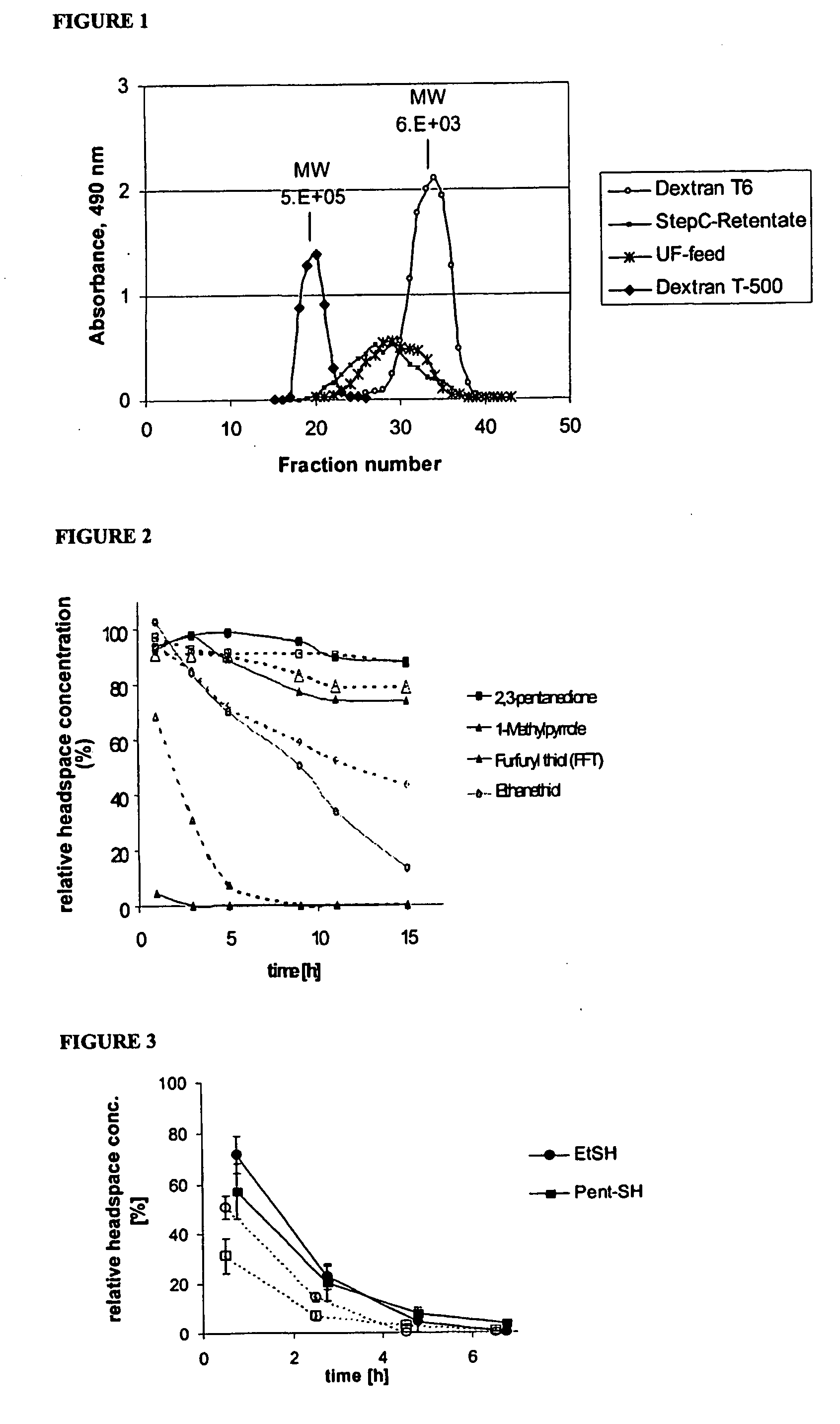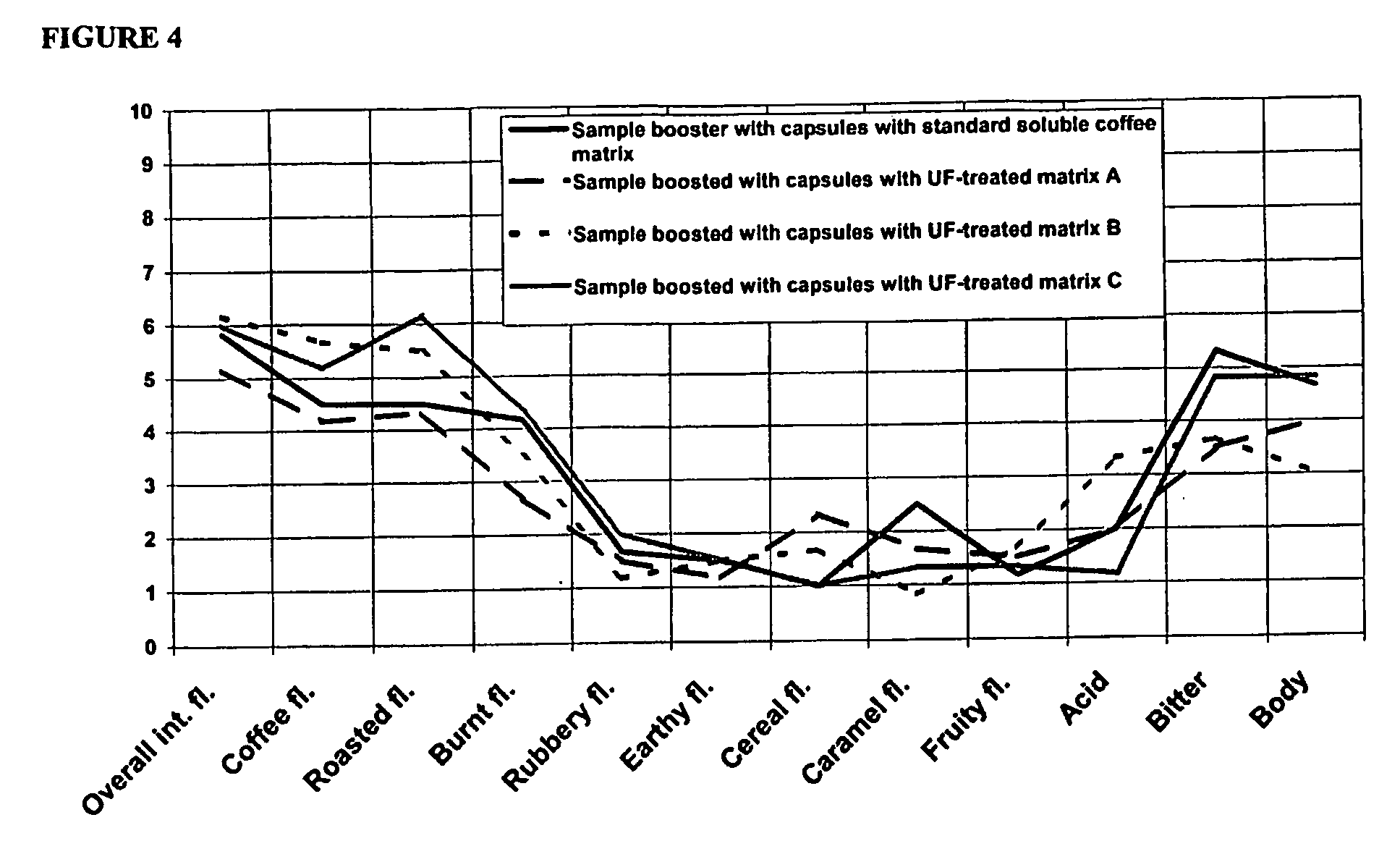Glassy Matrices for the Stabilzation of Coffee Aroma
- Summary
- Abstract
- Description
- Claims
- Application Information
AI Technical Summary
Benefits of technology
Problems solved by technology
Method used
Image
Examples
example 1
Preparation of Inert Matrix by Treatment with Polyvinylpolypyrrolidone
[0071] A 2% solution of soluble coffee in water (90 g soluble coffee, total weight 4500 g) was incubated with 225 g of polyvinylpolypyrrolidone in a batchwise fashion. After stirring for 1 h using a rotary agitator at room temperature, the suspension was filtered over a glass frit. Two washes were performed by resuspending the PVPP retained on the frit in 900 ml cold water (4° C.), stirring it for several minutes and filtering again. The filtrates were collected together and treated with a second batch of PVPP (113 g). After stirring for 1 h at room temperature, the suspension was treated as before. Finally, all filtrates were collected and freeze dried to yield 73 g of PVPP-treated matrix. Consequently, the overall recovery was 81%. The chlorogenic acid content was determined to be 20% of the feed.
example 2
Preparation of Inert Matrices by Ultrafiltration
[0072] A bench scale hollow fiber system operating in a feed-and-bleed mode (continuous mode) was used for the ultrafiltration trials. A back-flush anti-fouling technique was applied, whereby periodic back-flushing of the permeate back into the retentate was performed. In feed-and-bleed operation, feed material is continuously fed to the membrane systems and both retentate and permeate are taken off at a constant flow rate.
[0073] The solids content of the coffee extract used for the ultrafiltration trials was 7.5%. The coffee was heated to 60° C. for 5 min, cooled to room temperature and centrifuged in batches of 500 ml (Sorvall RC 5C, rotor GS3, 8900 rpm during 30 min at 16-20° C.) in order to remove insoluble materials. The final coffee solution (total solid content 6.3%) was stored frozen until used for the ultrafiltration trials. This material is referred to as the ultrafiltration feed.
[0074] In order to study the effect of the ...
example 3
Test to Establish the Reduced Levels of Aroma Degradation
[0082] The aroma stabilizing potential of the treated coffee extracts was estimated in solution. The relative change in the headspace concentration of a model volatile mixture was followed over time in presence of untreated and treated coffee matrix. SPME-GC-MS peak areas were measured at given time intervals and expressed as a percentage of peak area of the same volatile model mixture in plain water (blank reference). FIG. 2, which is a graph of the degradation kinetics of a model volatile mixture in the presence of UF retentate sample B (dashed line) and UF feed (solid line), and FIG. 3, which is a graph of the degradation kinetics of volatile thiols in the presence of a PVPP treated sample (solid line) and untreated coffee extract (dashed line), show that kinetic rate constants of volatile decay were in the range of 10 to 100 times lower in treated matrices than in the feed.
[0083] The coffee samples containing aroma were ...
PUM
 Login to view more
Login to view more Abstract
Description
Claims
Application Information
 Login to view more
Login to view more - R&D Engineer
- R&D Manager
- IP Professional
- Industry Leading Data Capabilities
- Powerful AI technology
- Patent DNA Extraction
Browse by: Latest US Patents, China's latest patents, Technical Efficacy Thesaurus, Application Domain, Technology Topic.
© 2024 PatSnap. All rights reserved.Legal|Privacy policy|Modern Slavery Act Transparency Statement|Sitemap


